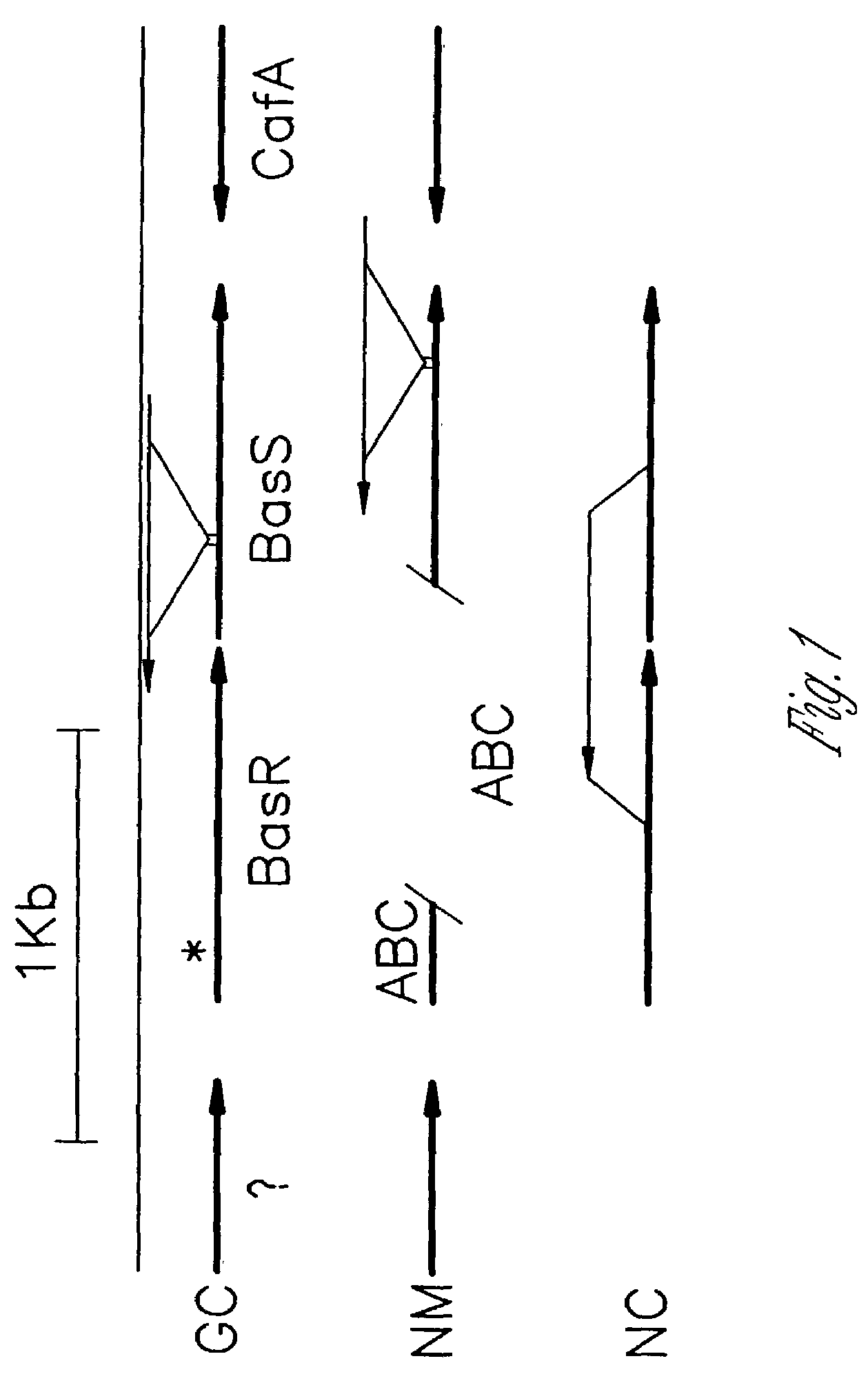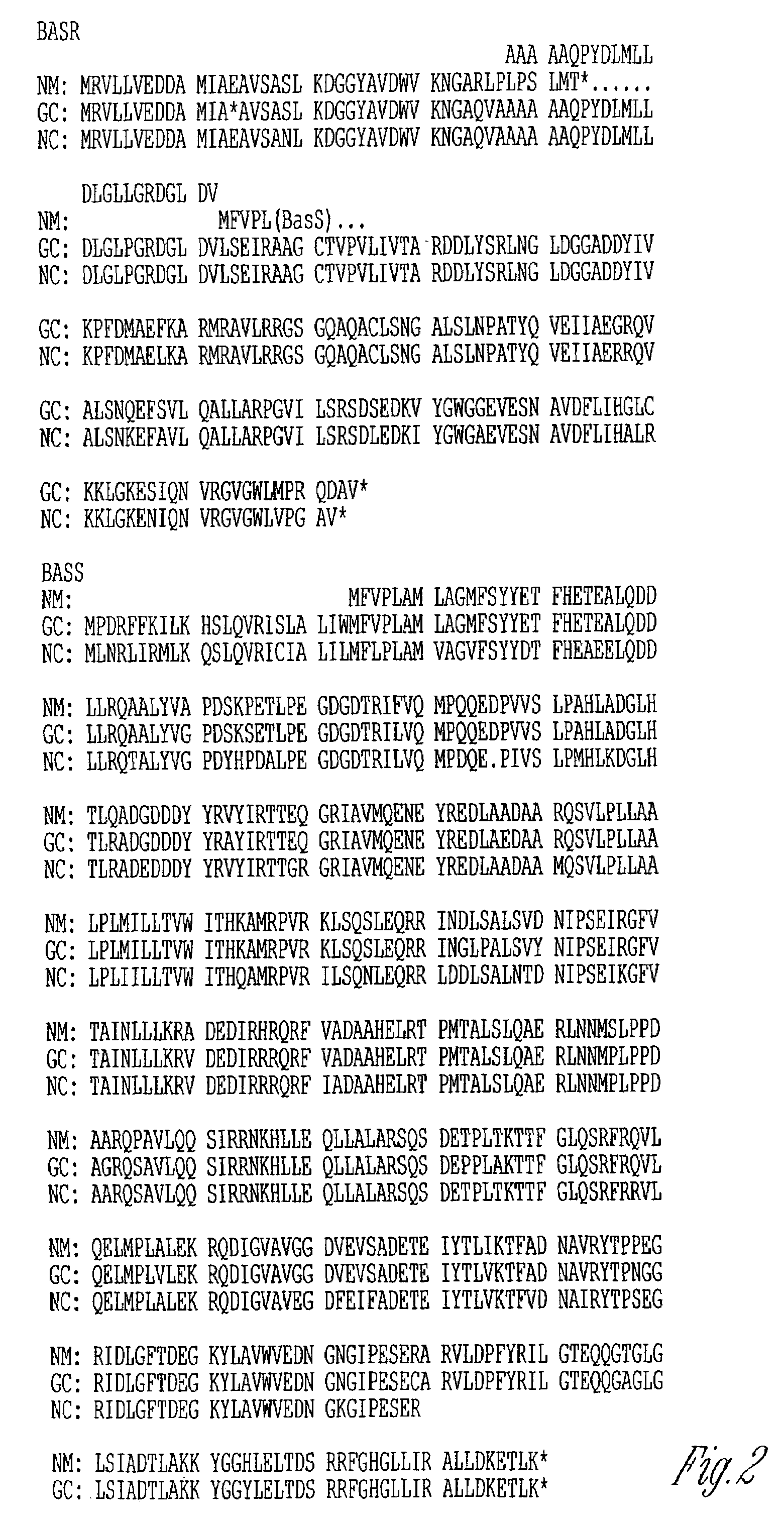Two-component system that controls bacterial membrane synthesis
a technology of bacterial membrane and synthesis, applied in the field of two-component system that controls bacterial membrane synthesis, can solve the problems of organisms that have often lost viability, will not grow in culture, and damage to brains or deaths before treatment can control the disease, etc., and achieve the effect of quick and easy determination
- Summary
- Abstract
- Description
- Claims
- Application Information
AI Technical Summary
Benefits of technology
Problems solved by technology
Method used
Image
Examples
example 1
Construction of the Super Blebber
A. Bacterial Strains and Plasmids
[0030]Wild type Neisseria strains used were N. gonorrhoeae 1291, N. meningitidis NMB and N. cinerea 601. Neisseria were grown on solid GC Base medium (Difco Laboratories, Detroit) supplemented with amino acids and vitamins. For growth of kantamycin resistant Neisseria, BHI agar was used (Difco) supplemented with 2.5% FCS. Liquid Neisseria cultures were grown in proteose peptone broth (proteose peptone No. 3, Difco) 15 grams per liter; soluble starch (Difco) 1 gram per liter, dibasic potassium phosphate 4 grams per liter; monobasic potassium phosphate 1 gram per liter; sodium chloride 15 grams per liter or in Morse's defined medium.
[0031]Escherichia coli strain XL1-Blue (Stratagene, LaJolla, Calif.) was used to maintain plasmids and was grown in liquid culture using LB broth or on solid medium using LB agar. Antibiotics were used at the following concentrations: ampicillin 100 μg / ml; kanamycin 50 μg / ml (E. coli) or 25 ...
example 2
Characteristics of the Super Blebbers
A. Chemical Analysis of the Outer Membrane of the Super Blebbers
[0044]The effect of the bmr mutation on several parameters was investigated by comparison of the N. gonorrhoeae wild-type and the mutant. Overnight cultures (10 ml) were killed by the addition of 0.5% phenol for two hours and outer membrane enriched samples were isolated as described by Zollinger et al., International Symposium, Hanasaari, Espoo, Finland (1991). Samples were analyzed by SDS-PAGE on a 6–15% gradient gel. LOS was isolated by phenol / chloroform / petroleum ether extraction as described by Galanos et al. Eur. J. Biochem.(1969) 9:45–249 and analyzed as described by Lee et al. J. Biol. Chem. (1995) 270:271151–9. The growth rate and outer membrane protein profile of the mutant were unaltered from the wild type.
[0045]Because of the homology of the Neisseria locus to the previously characterized bas locus of E. coli and S. typhimurium and the involvement of this system in LPS mo...
example 3
Use of the Neisseria bmr Mutants to Estimate Virulence of Bacteria Recovered from Clinical Samples
[0059]Swabs from suspected Neisseria infections are cultured for meningococcus or gonococcus by the methods disclosed in Example 1. A laboratory strain of Neisseria and a super blebber are grown in the same manner as controls. Overnight cultures are examined for blebbing in the SEM as described in Example 2B.
[0060]Phospholipids are isolated as described in Example 1. Phospholipids are quantitated as described by the incorporation of radionuclide or by HPLC analysis of total phospholipids. A level of phospholipid close to that of the super blebber indicates infection with a virulent neisserial pathogen, indicating that therapy should be immediate and aggressive.
[0061]As seen in Table III, a quantitative estimate on a scale of 1 (no blebbing) to 3 (many blebs and filamentous connections between cells) and the phospholipid content that correlates with blebbing are made to determine virulen...
PUM
| Property | Measurement | Unit |
|---|---|---|
| Fraction | aaaaa | aaaaa |
Abstract
Description
Claims
Application Information
 Login to View More
Login to View More - R&D
- Intellectual Property
- Life Sciences
- Materials
- Tech Scout
- Unparalleled Data Quality
- Higher Quality Content
- 60% Fewer Hallucinations
Browse by: Latest US Patents, China's latest patents, Technical Efficacy Thesaurus, Application Domain, Technology Topic, Popular Technical Reports.
© 2025 PatSnap. All rights reserved.Legal|Privacy policy|Modern Slavery Act Transparency Statement|Sitemap|About US| Contact US: help@patsnap.com



